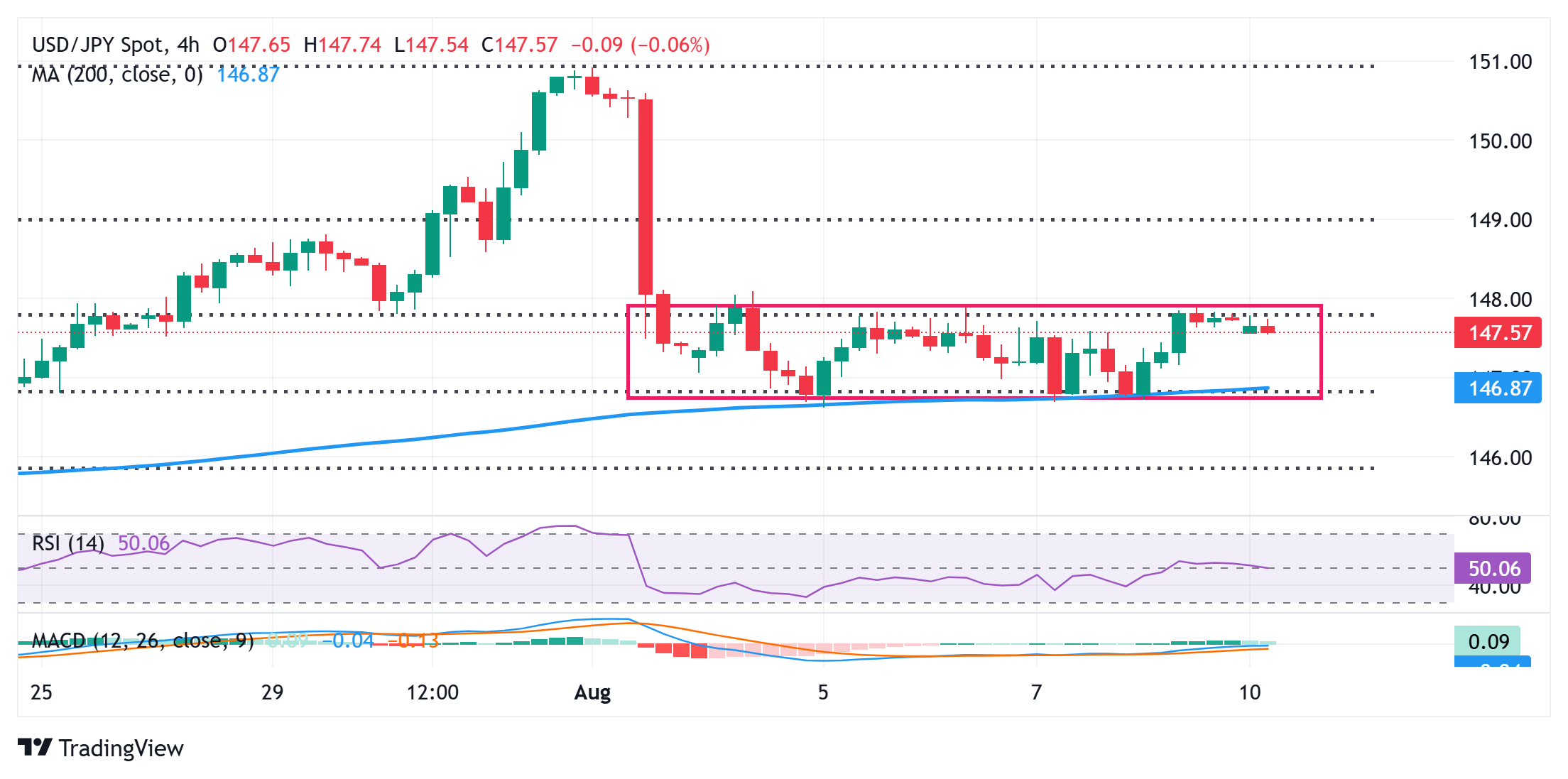Japanese Yen struggles to lure buyers amid mixed BoJ rate hike cues
- The Japanese Yen lacks a firm intraday direction amid the holiday-thinned liquidity on Monday.
- The uncertainty over the timing of the next BoJ rate hike keeps the JPY bulls on the defensive.
- Rising Fed rate cut bets undermine the USD and act as a headwind for the USD/JPY pair.
The Japanese Yen (JPY) kicks off the new week on a subdued note amid relatively thin liquidity on the back of the Mountain Day holiday in Japan. Traders also seem reluctant to place aggressive directional bets amid mixed Bank of Japan (BoJ) rate hike cues. Against the backdrop of worries about the potential negative impact of higher US tariffs, domestic political uncertainty suggests that prospects for BoJ rate hikes could be delayed further. The central bank, however, revised its inflation forecast at the end of the July meeting last week, and reiterated that it will raise interest rates further if growth and inflation continue to advance in line with its estimates.
This marks a significant divergence in comparison to dovish Federal Reserve (Fed) expectations, which caps Friday's modest US Dollar (USD) bounce from a two-week low and should act as a tailwind for the lower-yielding JPY. This keeps the USD/JPY pair below the 147.75-147.80 hurdle through the Asian session on Monday. Moving ahead, the market focus now shifts to the release of the latest US inflation figures – the Consumer Price Index (CPI) on Tuesday and the Producer Price Index (PPI) on Thursday. Apart from this, Japan's preliminary Q2 GDP print, also due on Thursday, will play a key role in providing some meaningful impetus to the currency pair.
Japanese Yen traders seem reluctant to place directional bets amid the BoJ uncertainty
- The Japanese Yen consolidates in a range during the Asian session on Monday amid the uncertainty over the likely timing of the next interest rate hike by the Bank of Japan (BoJ). In fact, the central bank left the door open for further policy normalization at the end of the July policy meeting. However, BoJ's Summary of Opinions showed on Friday that policymakers remain worried about the potential negative impact of higher US tariffs on the domestic economy, tempering expectations for an immediate rate hike.
- Major Asian indices, along with US equity futures, crept higher at the start of a new week. This turns out to be another factor undermining the safe-haven JPY. Investors, however, remain on edge amid the looming US tariff deadline on China, due to expire on Tuesday. Meanwhile, US President Donald Trump and Russian leader Vladimir Putin will meet in Alaska on Friday to discuss Ukraine. This might further contribute to keeping a lid on the market optimism and hold back traders from placing aggressive directional bets.
- The US Dollar attracts fresh sellers and erases a major part of Friday's modest recovery gains amid rising bets for more interest rate cuts by the Federal Reserve. The expectations were reaffirmed by Fed Governor Michelle Bowman's dovish remarks on Saturday, saying that three interest rate cuts will likely be appropriate this year. Bowman added that the apparent weakening in the labor market outweighs the risks of higher inflation to come. Traders are currently pricing in a nearly 90% chance of a rate cut in September.
- There isn't any relevant market-moving economic data due for release from the US on Monday, leaving the USD at the mercy of comments from influential FOMC members. The focus, meanwhile, will remain glued to the latest US consumer inflation figures on Tuesday. Apart from this, the preliminary Q2 GDP print from Japan and the US Producer Price Index on Thursday could provide a fresh impetus to the USD/JPY pair. The mixed fundamental backdrop, however, warrants caution before positioning for a firm near-term direction.
USD/JPY needs to find acceptance above 147.75-147.80 supply zone for bulls to seize control

Spot prices remain confined in a familiar range held over the past week or so, forming a rectangle pattern and pointing to a consolidation phase amid neutral technical indicators on hourly/daily charts. Hence, it will be prudent to wait for a sustained move and acceptance above the 147.75-147.80 barrier, representing the 38.2% Fibonacci retracement level of the upswing in July, before positioning for any further gains. Some follow-through buying beyond the 148.00 mark would be seen as a key trigger for bulls and lift the USD/JPY pair to the 148.45-148.50 region. The momentum could extend further towards the 23.6% Fibo. retracement level, just ahead of the 149.00 mark.
On the flip side, the 147.00 round figure now seems to protect the immediate downside ahead of the 146.80-146.75 confluence – comprising the 200-period Simple Moving Average (SMA) on the 4-hour and the 50% Fibo. retracement level. A convincing break below should pave the way for deeper losses and drag the USD/JPY pair to sub-146.00 levels, or the 61.8% Fibo. retracement level. Spot prices could extend the slide further and eventually drop to the 145.00 psychological mark.
Japanese Yen FAQs
The Japanese Yen (JPY) is one of the world’s most traded currencies. Its value is broadly determined by the performance of the Japanese economy, but more specifically by the Bank of Japan’s policy, the differential between Japanese and US bond yields, or risk sentiment among traders, among other factors.
One of the Bank of Japan’s mandates is currency control, so its moves are key for the Yen. The BoJ has directly intervened in currency markets sometimes, generally to lower the value of the Yen, although it refrains from doing it often due to political concerns of its main trading partners. The BoJ ultra-loose monetary policy between 2013 and 2024 caused the Yen to depreciate against its main currency peers due to an increasing policy divergence between the Bank of Japan and other main central banks. More recently, the gradually unwinding of this ultra-loose policy has given some support to the Yen.
Over the last decade, the BoJ’s stance of sticking to ultra-loose monetary policy has led to a widening policy divergence with other central banks, particularly with the US Federal Reserve. This supported a widening of the differential between the 10-year US and Japanese bonds, which favored the US Dollar against the Japanese Yen. The BoJ decision in 2024 to gradually abandon the ultra-loose policy, coupled with interest-rate cuts in other major central banks, is narrowing this differential.
The Japanese Yen is often seen as a safe-haven investment. This means that in times of market stress, investors are more likely to put their money in the Japanese currency due to its supposed reliability and stability. Turbulent times are likely to strengthen the Yen’s value against other currencies seen as more risky to invest in.

